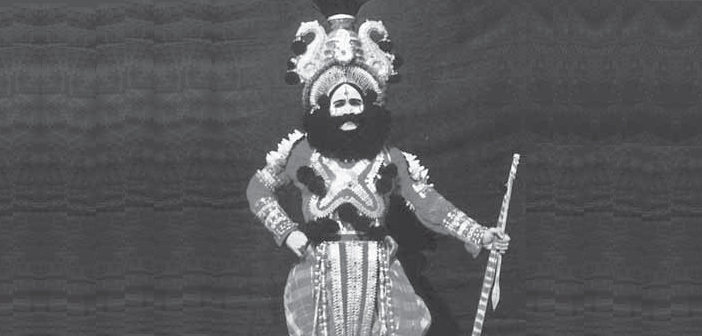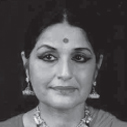Present-day Yakshagana is basically an open-air theatre. Even those who have been exposed to the truncated performances in urban theatres are struck by its compelling beauty and vigour. It is altogether a different experience to hear the Yakshagana drums, the chande and the maddale, sound through the night air and be drawn to a clearing in the paddy fields fringed by swaying coconut and areca palms, then to surrender oneself to the grip of the Yakshagana actors for six or seven hours, mingling dream and reality, and finally return to the routine of life towards the break of dawn. Generations of villages of west and north-west Karnataka have become familiar with the epic heritage for a number of highly individual creative artistes must have surely contributed to its development. By the sixteenth century, if not earlier, the Yakshagana dance-drama must have come to occupy a prominent place among the folk plays of Karnataka.
During the period mentioned above, most of this area was ruled by the kings of Vijayanagara (A.D. 1336-1565) with their capital at Vijayanagara, in the present Bellary district. An inscription found in the Lakshminarayana temple at Somasamudra of this district, mentions a land grant given to two Brahmins for arranging the performance of tala maddale in honour of the deity. This grant is dated 18 June 1556.
The play begins with a prologue called Sabhalakshana. By the time the Sabhalakshana comes to an end, the village audience would have all gathered and it would be time to start the prasanga proper. The performance lasts till the break of dawn. If the theme chosen is a short one, another theme is staged after the first. In some cases, three short themes may be presented during a single night. and the traditional system of values through Yakshagana, as well as the Mahabharata recitations.
A distinct folk art
Yakshagana is a distinct folk art of Karnataka. In spite of being a folk art, it has retained several classical elements. This is known also as the Bhagavatara Aata (a play performed with the help of a Bhagavata) and the Dashavatara Aata (a play representing the ten incarnations). The term Yakshagana is used in a wide connotation representing several allied forms. There was a time when it had flourished in the entire length and breadth of the Kannada country in one form or the other. This art, ancient and rich as well, with roots firmly established in the coastal region of Karnataka, has even today retained its natural form and popularity. This has for hundreds of years continued to be the medium of entertainment and dissemination of knowledge in Karnataka’s rural areas.
The present theatrical form of the Yakshagana play consists of three different mediums of expression – language, music and dance – besides costume and make-up. Its spoken prose, never learnt by heart, but always improvised on the spur of the moment, has vanished. Even with regard to its musical form, a lot seems to have changed. In the matter of dance too, which had to be learnt by assiduous practice, much has probably been lost. At the same time, it is possible to assume that the dance has also gained, for a number of highly individual creative artistes must have surely contributed to its development. By the sixteenth century, if not earlier, the Yakshagana dance-drama must have come to occupy a prominent place among the folk plays of Karnataka.
During the period mentioned above, most of this area was ruled by the kings of Vijayanagara (A.D. 1336-1565) with their capital at Vijayanagara, in the present Bellary district. An inscription found in the Lakshminarayana temple at Somasamudra of this district, mentions a land grant given to two Brahmins for arranging the performance of tala maddale in honour of the deity. This grant is dated 18 June 1556.
The play begins with a prologue called Sabhalakshana. By the time the Sabhalakshana comes to an end, the village audience would have all gathered and it would be time to start the prasanga proper. The performance lasts till the break of dawn. If the theme chosen is a short one, another theme is staged after the first. In some cases, three short themes may be presented during a single night.
Staging the performance
The stage is constructed in a paddy field or a temple yard, at a place easily accessible to all. Behind the stage, a raised bench, or a table or two are placed for the Bhagavata and his accompanists. Some more space is left on either side for the entry and exit of the characters of the play. The characters enter the stage from the Bhagavata’s left side and exit from his right. At the right hand corner sits the man who plays the chande. This is a high strung drum played with two sticks, and it can be heard to a great distance. Another drum, the maddale is played by a drummer who usually keeps standing to the left of Bhagavata.
Custom ordains that the stage should not face east on Sundays and Thursdays, west on Tuesdays, and north on Wednesdays and Saturdays, for it is believed that Rahu, the evil planet, haunts these directions on those days, rendering them unpropitious. Temple yards are an exception to this rule, and in case the place chosen makes it impossible to observe these taboos, Rahu has to be appeased through some prescribed ritual or the other.
In Yakshagana it has been the custom from time immemorial for the males to play both the male as well as the female roles. Before they begin their make-up, the artistes who play the male roles put on black pajamas and those who play the female roles put on skirts. They tie up their hair and proceed to paint their faces. The make-up is usually simple in the case of female roles, but intricate in the case of special roles like those of a kirata (hunter), a gandharva (celestial being), a rakshasa (demon), or a rakshasi (demoness).
The Bhagavata, along with the musicians who provide him instrumental accompaniment, emerges from the chauki (green-room) and arrives on the chauka (the stage). He is followed by the Hanumanayaka, the Hasyagara or clown, and his tribe of kodangis.
The Hanumanayaka is the counterpart of the Vidushaka of the Sanskrit dramas. The chief difference is that the Vidushaka’s role is quite specific, for he follows the written text; no such written text is binding on the Hanumanayaka. Even when he plays a role in the main prasanga, his speech is unbridled.
His traditional dress consists of a red-bordered white dhoti, a loose white upper garment, and a red and white turban of large proportions. Beneath his dhoti he wears the usual black pajama. His gait is easy and his manner of speaking witty. His followers, a few boys who are called kodangis (monkeys), come half clad, with mango leaves tied to their body, to signify their simian role.
Speech, music, extensive gestures
Yakshagana plays are often likened to Kathakali plays of Kerala or Kuchipudi plays of Andhra. Kathakali of Kerala has its own musical style, but it eschews the spoken word entirely. Instead it uses a gesture language of its own to express the meaning of its songs. Kuchipudi has a similar gesture language. But Yakshagana employs the speech medium extensively in depicting its dramatic situations. Here, the function of dance is not total but only partial, though all the characters that appear on the stage do dance, as the Bhagavata sings his songs to the accompaniment of the maddale and cymbals. The musical structure of all the songs, and sometimes of the verses too, lends itself to rhythmic dance. The essential difference between the Yakshagana drama and the other two systems is the role of speech.
Yakshagana dance form consists mostly of the nritta aspects of footwork and rhythmical body movementsincluding those of the neck, arms and palms. It contains some fine postures, body flexions, as well as a few squatting, jumping and reeling movements. What it lacks is a stylised gesture language employing symbolic hastas to depict parts of speech. The few gestures and symbols used are the ones that one normally uses in day to day conversation.
For the sake of simplification we can split the Yakshagana characters into a few definite categories. Valiant heroes or warriors like Karna, Arjuna etc., Gods and God incarnates that come to the Earth and toil with or for such heroes, also belong to this group. There is another similar group, but with a little slant in its nature. They too are valiant, but quite often flamboyant, vain or even silly. Under this category, we may include persons like Indra and Gaya. Another such type is a combination of the valiant type with rustic behaviour. In this class comes the kirata or the hunter. There is another class of a different type altogether consisting of rakshasa and rakshasi who signify strength, valour etc., but are evil and cruel by nature. They are personalities that strike terror into the hearts of people.


